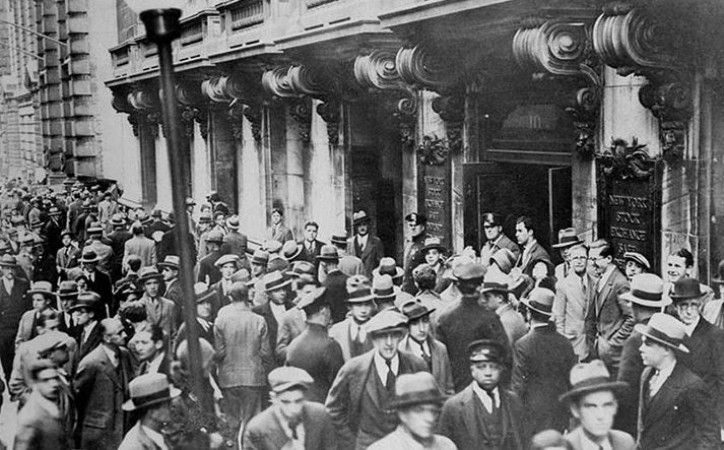
Introduction
The Stock Market Crash of 1929, also known as Black Tuesday, was a catastrophic event that occurred on October 29, 1929. It marked the start of the Great Depression, one of the most severe economic downturns in history. This article delves into the causes, impact, and aftermath of the stock market crash, shedding light on the events that led to the collapse and the long-lasting effects it had on the global economy.
The Roaring Twenties: A Prelude to Disaster
In the 1920s, the United States experienced a period of unprecedented economic prosperity known as the Roaring Twenties. The stock market soared, and many Americans eagerly invested their money in the hopes of making quick profits. However, this era of wealth and excess was built on a fragile foundation.
Overconfidence and Speculation
One of the key factors leading to the stock market crash was the overconfidence and speculative behavior of investors. As stock prices continued to rise, people became increasingly optimistic about the future, fueling a speculative frenzy. Investors were driven by the belief that stock prices would keep climbing indefinitely, leading to an unsustainable bubble.
Weaknesses in the Banking System
Another contributing factor to the crash was the weakness in the banking system. Banks were engaging in risky lending practices, granting loans to investors who used them to buy stocks. This created a cycle of debt and leverage, with borrowers relying heavily on the future performance of stocks to repay their loans. When the market crashed, many borrowers were unable to repay their debts, causing a ripple effect throughout the banking system.
The Market Panic Begins
In September 1929, the stock market experienced a sharp decline, leading to widespread panic among investors. Many began selling their stocks in a frantic attempt to cut their losses. This initial panic was a warning sign of the imminent crash, as it revealed the fragility of the market and the vulnerability of investors.
Black Tuesday: The Stock Market Plummets
On October 29, 1929, Black Tuesday struck with full force. In a single day, the stock market lost billions of dollars in value, leaving investors devastated. Panic selling reached its peak, with millions of shares traded at significantly lower prices. The crash was so severe that it wiped out fortunes and exposed the flaws in the financial system.
The Great Depression Unfolds
The stock market crash of 1929 triggered a chain reaction of economic events that led to the Great Depression. The crash severely damaged investor confidence and caused a sharp decline in consumer spending. Businesses struggled, leading to layoffs and a rise in unemployment rates. The economy plunged into a deep recession, and the effects were felt not only in the United States but also around the world.
Unemployment and Poverty Escalate
As the Great Depression deepened, unemployment rates skyrocketed, reaching record highs. Millions of people lost their jobs, and families faced extreme poverty. The lack of income and resources resulted in widespread suffering and hardship, with many struggling to make ends meet. This period marked one of the darkest chapters in American history.
Government Response and New Deal Policies
In response to the economic crisis, the U.S. government implemented a series of measures known as the New Deal. President Franklin D. Roosevelt introduced programs aimed at stimulating the economy, creating jobs, and providing relief to the American people. The New Deal initiatives included infrastructure projects, financial reforms, and social welfare programs, helping to alleviate some of the effects of the Great Depression.
Lessons Learned from the Crash
The stock market crash of 1929 taught valuable lessons about the dangers of speculation, excessive risk-taking, and the importance of regulatory oversight. It highlighted the need for stricter financial regulations to prevent future crises and protect investors and the economy. The crash also emphasized the importance of diversification and long-term investment strategies, rather than relying solely on short-term gains.
The Lasting Legacy of the Stock Market Crash
The stock market crash of 1929 and the subsequent Great Depression had a profound and lasting impact on the world. It shattered the illusion of economic invincibility and brought about significant changes in economic policies, financial regulations, and social safety nets. The crash served as a stark reminder of the fragility of the financial system and the importance of maintaining stability to prevent such catastrophic events.
Conclusion
The Stock Market Crash of 1929 marked a critical turning point in history, signaling the beginning of the Great Depression. It was a wake-up call that exposed the vulnerabilities and weaknesses of the financial system. The crash had far-reaching consequences, causing widespread unemployment, poverty, and suffering. However, it also led to important lessons and reforms that shaped the future of finance and the economy.
Manipur Violence: Tribal Leader Forum Regrets Kuki Zo Conflict